|
| |
Archives
|
Saturday December 16 2006
|
no wind
That went a little bit better than expected. The first part of the storm came through with some flickering of lights Thursday night. At midnight I could see the radar map had Whidbey Island in the middle of a ring of rain. the lights went our shortly after the second rain hit. We heard the power would be out 4 to 7 days but it came back on this afternoon. Many on the island still without power as well as the mainland. Just catching up.
|
Thursday December 14 2006
|
wind
A big windstorm is due in tonight and they are saying we may be without power for three days. If I don't show up after three days, send out the search dogs. The ones with the brandy casks. If you can find ones with casks of single malt scotch, that would be even better. Later...
america the beautiful redux
Somewhere a Banker Smiles
Muffled noises from the ranks of the babbling paranoid
by Joe Bageant
|
It's hard as hell to keep conspiracy theories out of one's mind these days. And I'm not talking about "Who really brought down the Twin Towers? or the "Are Zionists behind the Iraq War?" kind of stuff. The booger stalking my ragged old mind these days puts both of those in the shade. And it runs like this:
Is the consumerist totalization of this country and the world really a conscious plot by a handful of powerful corporate and financial masters? If we answer "yes" we find ourselves trundled off toward the babbling ranks of the paranoid. Still though, it's easy enough to name those who would piss themselves with joy over the prospect of a One World corporate state, with billions of people begging to work for their 1,500 calories a day and an xBox chip in their necks. It's too bad our news media quit hunting with live ammo decades ago, leaving us with no one to track the activities and progress of what sure as hell seem to be global elites, judging from the financial spoor we find along every pathway of modern life.
In our saner moments we can also see that it does not take dark super-centralized plotting to pull off what appears to have been accomplished. Even without working in overt concert, a few thousands of dedicated individual corporate and financial interests can constitute a unified pathogenic whole, much the same as individual cells create a viable dominant colony of malignant organisms -- malignant simply by their anti-human, anti-societal nature. We don't see GM, Halliburton, Burger King and CitiBank lobbying the state for universal health or clean rivers, do we? But mention unions or living wages, and the financial colony within our national Petri dish shape shifts into a Gila monster and squirts venom on the idea and shits money all over Capitol Hill. I looked at all this as coincidence for years until the proposition finally strained credulity so much that I threw in the towel and said, "Fuck it. There is only so much coincidence to go around in this world."
| |
[more]
photography
We think of the Great Depression in black and white becasue that was the way it was shot. But by the end of the depression color Kodachrome was available. It looks different. (Duh!) I've posted about this before but here is a page with a lot of examples and links to find more.
America Before Pearl Harbor - Early Kodachrome Images

|
Color presents an entirely different image.
This is a photograph of Faro and Doris Caudill, farmers in Pietown, New Mexico. They lived in a dugout and struggled to survive on Resettlement Administration land.
As the 1930s came to a close, Kodak came out with Kodachrome film – the first commercially viable color film available to the general public. In 1937 and 1938, the colors were still not stable and accurate, but by 1939 Kodachrome was producing color images of remarkable precision.
| |
[more]
thanks to Neatorama
middle east clusterfuck
Mideast allies near a state of panic
U.S. leaders' visits to the region reap only warnings and worry.
|
President Bush and his top advisors fanned out across the troubled Middle East over the last week to showcase their diplomatic initiatives to restore strained relationships with traditional allies and forge new ones with leaders in Iraq.
But instead of flaunting stronger ties and steadfast American influence, the president's journey found friends both old and new near a state of panic. Mideast leaders expressed soaring concern over upheavals across the region that the United States helped ignite through its invasion of Iraq and push for democracy — and fear that the Bush administration may make things worse.
| |
[more]
music
Cylinder Preservation and Digitization Project
|
Cylinder recordings, the first commercially produced sound recordings, are a snapshot of musical and popular culture in the decades around the turn of the 20th century. They have long held the fascination of collectors and have presented challenges for playback and preservation by archives and collectors alike.
With funding from the Institute of Museum and Library Services, the UCSB Libraries have created a digital collection of over 6,000 cylinder recordings held by the Department of Special Collections. In an effort to bring these recordings to a wider audience, they can be freely downloaded or streamed online.
On this site you will have the opportunity to find out more about the cylinder format, listen to thousands of musical and spoken selections from the late 19th and early 20th centuries, and discover a little-known era of recorded sound. Click the search button to begin, or sample some of our favorite selections in the featured cylinder section or by listening to online streaming radio.
| |

Three minutes with the minstrels / Arthur Collins, S. H. Dudley and Ancient City. Edison Record: 4705. 1899.
[more]
I listened to that cylinder in the picture. Wow! Listening to a song recorded in 1899.
thanks to Neatorama
iraq
That Iraq Report? More of the Same
The great Baker-Hamilton crock: A classic bullshit-cloud in the proud tradition of congressional "studies"
|
Baker-Hamilton was a classic whore-panel in every sense. None were Middle East experts. None had logged serious time in Iraq, before or after the invasion. All of them had influential friends on both sides of the aisle all over Washington, parties in the future they wanted to keep getting invites to, ambitions yet to be realized. You could assign Jim Baker, Lee Hamilton, Sandra Day O'Connor and Vernon Jordan, Jr. to take on virtually any problem and feel very confident that between the four of them, they would find a way to avoid the ugly heart of any serious political dilemma. If the missiles were on the way, and nuclear Armageddon was just seconds off, those four fossils would find a way to issue a recommendation whose headline talking points would be something like "heightened caution," dialogue with Sweden, and a 14 percent increase in future funding for the Air Force.
Hence the conclusions of the Baker-Hamilton report were predetermined virtually from the start. We could all have expected that the group's only unequivocal conclusions would restate the obvious -- that we need an eventual withdrawal of troops, that there needs to be more "robust regional diplomacy," that Iraqi forces need to assume more of the security burden, and that there will be no hope of a political solution without some cooperation from Syria and Iran. Duh! Because the really thorny questions are the specifics: when do we leave, and, more importantly, what do we offer Iran and Syria in return for their cooperation, what horrifying inevitable humiliation will we be prepared to suffer at their hands, and what form will talks with those gloating countries take?
Baker-Hamilton blew off those questions, and it's no wonder, because no one in Washington wants to deal with them. The Republicans don't want to agree to a withdrawal timetable because it's an admission of defeat and policy failure, while the Democrats don't want to be the first to call for a withdrawal because they're afraid of being pilloried in the next election season for a lack of toughness. Both sides are afraid of being responsible for a civil war bloodbath if the U.S. troops pull out, and neither side wants to be the first to suggest taking the humiliating step of inviting Syria or Iran to the negotiating table with anything like equal status.
| |
[more]
thanks to The Agonist
A New U.S. Option in Iraq: Panic!
|
Things really are coming apart so quickly in Iraq that some blogging appears to be in order. No sooner had we noted that Washington’s Arab allies are pushing it hard to remain engaged and protect the Sunnis then the Washington Post reports (thanks, Pat!) that the State Department has been pushing for the U.S. to abandon its efforts to draw the Sunni insurgents into a new political order because that is alienating the Shiites — and as I noted below, it’s untenable for the U.S. military to remain in Iraq if it is at odds with two thirds of the population. The proposal to ditch efforts to draw in the Baathists is attributed to Philip Zelikow, which makes the fact that he resigned last week all the more intriguing.
It’s not hard to imagine that the bomb-Iran faction of the Administration is having none of this cozying up to the Shiites business, and Dick Cheney’s huddle with the Saudi king last weekend would certainly have been about mobilizing an alliance of Sunni regimes to push back against Iranian influence both inside Iraq and beyond.
| |
[more]
Bush, Baker and Iraq: Why the Patient Can Not Be Saved
|
Discussing the report of his bipartisan Iraq Study Group with the Senate Armed Services Committee this week, former Secretary of State and Bush-pere fixer James Baker must have already sensed the inevitability that nothing will come of his efforts to salvage the mess young Bush has made in Iraq: “I hope we don’t treat this like a fruit salad, saying, ‘I like this, but I don’t like that,’ ” Baker told the senators, to warn them away from their own line-item-veto approach to it. “It’s a comprehensive strategy designed to deal with the problems in Iraq, but also to deal with other problems in the region. These are interdependent recommendations.” Not according to President Bush, who told a news conference the same day he was sure Baker and Lee Hamilton didn’t expect him to embrace all of their recommendations. He also made it abundantly clear that some of its most important proposals are to his tastes what broccoli was to his father’s. Exhibit A: Talks with Iran and Syria over Iraq — Bush made clear he had no intention of following that one. (Instead, he reiterated his preconditions for allowing Iran and Syria to help the U.S. out in Iraq! Uh, I think you may want to think in terms of incentives; they’re the ones who’re going to have the preconditions, Mr. President…)
That position is likely to be reinforced by such head-in-sand hawks as Cheney and the plays-one-on-TV grand strategist Condi Rice, fiercely egged on by the Israel-first crowd, who see any rapprochement between Washington and either Tehran or Damascus as a danger to be aggressively countered. And the commonsense linkage made by Baker-Hamilton between prospects for success in Iraq and in the wider Middle East showing U.S. willingness to act in an even-handed way between Israel and the Palestinians, first and foremost by forcing them back to the peace table, is, predictably, being hysterically denounced Likud’s American cheering section. Then again, Israel’s Prime Minister Ehud Olmert is so confident that Bush won’t change his position on Iran and Syria that he told his cabinet to keep mum on the issue, lest they make it look as if Israel is inappropriately intervening.
| |
[more]
The Children's Crusade/Thirty Years War
|
David Brooks tells us today that American withdrawal from Iraq will leave a disrupted region in such a state that a general regional war initially centered in Iraq will result and he compares that coming war to the "Thirty Years War" which devastated much of Europe causing a loss of 50% of the population in some places.
I support this analysis whether he likes that or not.
I differ from him in two areas that are at least implied by lacunae in his screed.
1 - He shows no evidence of thinking that the situation in Iraq has passed beyond American ability to control events at the macro level. It is over, David, just over... No amount of blather can change that. Partition Iraq? Hah!! Iraq is well on its way to completing its own partition. Ethnic cleansing is underway throughout the country, neighborhood fights neighborhood throughout Baghdad while the Kurds look on with apprehension over American reliability. It is over. We should now look to our options in dealing with the wreckage of Mesopotamia and the "cockpit" into which we have made the Middle East. Immediate withdrawal? Not unless it is part of the answer in dealing with the wreckage. More trainers and advisers? Perhaps, if we think that reasonable relations with the Shia "rump" state of Iraq will be sufficiently important in the context of the "Second Thirty Years War" to warrant the expenditure in blood and money and the risks inherent in maintaining a smaller and therefore more vulnerable force in Iraq.
| |
[more]
The Baker Boys: Stay Half the Course
Iraq Study Group or Saudi Protection League?
by Greg Palast
|
They’re kidding, right?
James Baker III and the seven dwarfs of the “Iraq Study Group” have come up with some simply brilliant recommendations. Not.
Baker’s Two Big Ideas are:
1. Stay half the course. Keeping 140,000 troops in Iraq is a disaster getting more disastrous. The Baker Boys’ idea: cut the disaster in half — leave 70,000 troops there.
But here’s where dumb gets dumber: the Bakerites want to “embed” US forces in Iraqi Army units. Question one, Mr. Baker: What Iraqi Army? This so-called “army” is a rough confederation of Shia death squads. We can tell our troops to get “embedded” with them, but the Americans won’t get much sleep.
| |
[more]
thanks to David Iles
Will Bush choose his new friends over his old?
The president's Shiite allies in Iraq really don't like some of James Baker's Sunni-friendly suggestions.
By Juan Cole
|
At a press conference on Thursday, George Bush was asked whether he was "in denial" about Iraq. "It's bad in Iraq," he shot back, to laughter. "That help?" He also noted that the report of the Jim Baker-led Iraq Study Group, which was released Wednesday, was important enough that he had read it.
But the immediate speculation in Washington was that even if the president has really accepted that things are "bad," it doesn't mean he's ready to follow the ISG's advice on how to make things better. Some wondered which prescriptions he would ignore, while others suggested he might be trying to sabotage the ISG's suggested remedies altogether.
| |
[more]
photography
Experimental Friends: Nathan Lerner and Edmund Teske
|
Chicago-born Edmund Teske and Nathan Lerner began photographing in the streets of their native city in the early 1930s and each has a wonderful body of work rich in affectionate social documentation and rewarding in the formal qualities of design and technical execution. As the years went by, both artists largely abandoned classical representation to become major exponents of increasingly experimental approaches to this expanding medium. Here their paths diverged.
| |

[more]
thanks to consumptive.org
war! what is it good for?
Reader Yolanda Flanagan passed this link on to me. I've linked to the words of General Smedley D. Butler before. He always bears rereading.
War is a Racket
By General Smedley D. Butler
|
War is just a racket. There are only two things we should fight for. One is the defense of our homes and the other is the Bill of Rights. War for any other reason is simply a racket.
It may seem odd for me, a military man to adopt such a comparison. Truthfulness compels me to. I spent thirty-three years and four months in active military service as a member of this country's most agile military force, the Marine Corps. I served in all commissioned ranks from Second Lieutenant to Major-General. And during that period, I spent most of my time being a high class muscle-man for Big Business, for Wall Street and for the Bankers.
I suspected I was just part of a racket at the time. Now I am sure of it. Like all the members of the military profession, I never had a thought of my own until I left the service. My mental faculties remained in suspended animation while I obeyed the orders of higher-ups. This is typical with everyone in the military service.
I helped make Mexico safe for American oil interests in 1914. I helped make Haiti and Cuba a decent place for the National City Bank boys. I helped in the raping of half a dozen Central American republics for the benefits of Wall Street. I helped purify Nicaragua for the international banking house of Brown Brothers in 1909-1912. I brought light to the Dominican Republic for American sugar interests in 1916. In China I helped to see to it that Standard Oil went its way unmolested.
During those years, I had, as the boys in the back room would say, a swell racket. Looking back on it, I feel that I could have given Al Capone a few hints. The best he could do was to operate his racket in three districts. I operated on three continents.
| |
[more]
Some things don't seem to change.
bicycles
Atomic Zombie Extreme Machines

[more]
thanks to Neatorama
palestine/israel
Former President Jimmy Carter has thrown the proverbial turd into the punchbowl with his new book Palestine: Peace Not Apartheid. I have it on hold at my local library (I'm number 21 with 5 copies.) I will bring my own report on it when I read it. Until then...
Speaking frankly about Israel and Palestine
Jimmy Carter says his recent book is drawing knee-jerk accusations of anti-Israel bias.
By Jimmy Carter
|
I SIGNED A CONTRACT with Simon & Schuster two years ago to write a book about the Middle East, based on my personal observations as the Carter Center monitored three elections in Palestine and on my consultations with Israeli political leaders and peace activists.
We covered every Palestinian community in 1996, 2005 and 2006, when Yasser Arafat and later Mahmoud Abbas were elected president and members of parliament were chosen. The elections were almost flawless, and turnout was very high — except in East Jerusalem, where, under severe Israeli restraints, only about 2% of registered voters managed to cast ballots.
The many controversial issues concerning Palestine and the path to peace for Israel are intensely debated among Israelis and throughout other nations — but not in the United States. For the last 30 years, I have witnessed and experienced the severe restraints on any free and balanced discussion of the facts. This reluctance to criticize any policies of the Israeli government is because of the extraordinary lobbying efforts of the American-Israel Political Action Committee and the absence of any significant contrary voices.
| |
[more]
thanks to Antiwar.com
Jimmy Carter and the "A" Word
Will Other Democrats Listen to Carter on Palestine?
|
President Jimmy Carter's latest book Palestine: Peace Not Apartheid (Simon and Schuster 2006), released yesterday, has been primed for controversy. Weeks before it hit the bookshelves, election-hungry Democrats were disavowing it because it used the word "apartheid" to describe the discrimination against Palestinians living in the Occupied West Bank and Gaza Strip. House Representative and soon-to-be Majority Leader Nancy Pelosi wrote: "It is wrong to suggest that the Jewish people would support a government in Israel or anywhere else that institutionalizes ethnically based oppression, and Democrats reject that allegation vigorously." But does the President's book really warrant the swift condemnation leveled against it by his own party?
To put the name "apartheid" to Israeli policies is nothing new. Hendrik Verwoerd, South African Prime Minister and architect of apartheid did so in 1961. Israeli academic Uri Davis made the claim in 1987, as did Nobel laureate Desmond Tutu in 1989 and again in 2002. What makes Jimmy Carter unique is that he is the first U.S. President to make that comparison. Unlike the others, Carter's description is carefully qualified. He writes: "The driving purpose of the separation of the two peoples is unlike that in South Africa not racism but the acquisition of land" (189-190). What's more, Carter's assessment of Israeli policies towards the Palestinians contradicts the observations he catalogues in his own text. He writes that "There has been a determined and remarkably effective effort to isolate settlers from Palestinians, so that a Jewish family can commute from Jerusalem to their highly subsidized home deep in the West Bank on roads from which others are excluded, without ever coming in contact with any facet of Arab life" (190).
| |
[more]
Peace Not Apartheid
Jimmy Carter's Roadmap
by Norman Finkelstein
|
The historical chapters of Palestine Peace Not Apartheid are rather thin, filled with errors small and large, as well as tendentious and untenable interpretations. But few persons will be reading it for the history.
It is what Carter has to say about the present that will interest the reading public and the media (assuming the book is not ignored). It can be said with certainty that Israel's apologists will not be pleased. Although Carter includes criticisms of the Palestinians to affect balance, it is clear that he holds Israel principally responsible for the impasse in the peace process. The most scathing criticisms of Israel come in Chapter 16 ("The Wall as a Prison"). One hopes that this chapter (and the concluding "Summary") will be widely disseminated.
Below I reproduce some of Carter's key statements.
| |
[more]
Carter On Apartheid Israel
|
Jimmy Carter has out a book called "Palestine Peace Not Apartheid". It seems the book itself may contain some glaring errors, as the NJDC (who aren't reflexively hawkish on Israel) point out.
However the bottom line that, as I understand it, Carter points out, is that as long as Israel has settlements in Palestinian turf, Israel is not serious about peace with the Palestinians. Nor will they get it. They signed the peace map, went back to Tel Aviv, and kept sending settlers in. Israel was never serious about the peace map. You'll notice that the attached graph from Haaretz shows no hiccup in the numbers in the 90's at all. I'm not pretending that the Palestinians are angels - most of their leaders are scum and they've done awful things and never lost an opportunity to lose an opportunity. But I also know what the casualty figure ratios are and I know who's suffering more from this.
There is also the other argument about whether Israel is an apartheid state. I don't see how one can argue that it isn't, since about 40% of the population has effectively no rights of citizenship, no right to a trial, no right of free movement, and Palestine has spent decades having its land appropriated and cut into chunks (the idea that Israel doesn't rule the land is also a non starter when they kidnap members of the "Palestinian" government at will).
| |

[more]
Apartheid Israel
A Beacon of Hope
By Virginia TilleyVirginia Tilley
|
And, just as apartheid did in southern Africa, Israel's fearful and zealous commitment to racial exclusion of the indigenous people is tearing the entire region apart.
What do we get from recognizing this fact? We may take clues from public indications that Ariel Sharon before his stroke and Mr. Olmert after him have been terribly anxious that we not do so. For what can Israel do if it is truly held accountable for denying its territorial population the right to vote? How can it exclude its native people from equal citizenship if they ask for it? The common defence, the need to preserve Jewish statehood, will instantly ring hollow. For Israel styles itself a western-style democracy. Yet no western democracy is presently attacking its own territory's population with mortar barrages and helicopter gunships solely because of their ethnic identity. No western democracy is blasting whole families to bits with mortars solely because their ethnicity is unwelcome. No western democracy is now encircling millions of people within walled cantons solely on the basis of their religion or ethnicity.
Like "White Australia" and apartheid South Africa before it, Israel is attempting to be racial state and a democratic state at the same time. No western democracy has survived the obvious contradictions of this formula: they all had to give it up. And apartheid Israel will not survive it if we call the shots as they are. Like the US, South Africa, New Zealand, and "White Australia" before it, Israel must admit its Muslim and Christian population as citizens and then grapple with the ensuing tough work of pluralist democracy like the rest of us.
This was the hard-won South African solution, where the state now represents everybody. Seventeen languages and differing historical narratives are recognized and dignified. Whites have retained their property and wealth, while black Africans are rising rapidly to join the middle and upper classes. After some early economic missteps, the government has launched new social policies and steered booming trade with the African continent that are channelling wealth and rapid growth throughout the country. The press is free and vibrant. Is South Africa still struggling for racial equality and economic justice? Sure. Is it plagued by the racial legacy of settler colonialism? Sure. But ongoing struggles for equality and mutual respect are the human condition and the noble burden of democracy. South Africa is a vigorous, growing, vital society. And there is peace.
John Dugard, the eminent South African legal scholar and UN Special Rapporteur on the Question of Palestine, wrote frankly in the Atlanta Journal-Constitution that racial oppression in Israel is worse than it was in South Africa. But his assessment also offers hope. Identifying that we presently have a one-state solution - Israel's apartheid version - allows us to affirm a different one: a unified secular-democratic state, in which everyone is equal in dignity and rights, and where the Jewish and Palestinian national homes can share the land as they should. With that shared goal, disparate activist struggles around the world can find, at last, true direction.
| |
[more]
Elbow to elbow, like cattle
By Gideon Levy
|
Laila El-Haddad spent the last three weeks in a dismal apartment she was forced to rent in El Arish, Egypt, together with her son Yusuf, who is two years and nine months old. Every few days the two tried to travel to the Rafah border crossing, about 50 kilometers away, attempting to return to their home in Gaza. These were distressful efforts: Together with another 5,000 or so residents of Gaza, who have also been waiting in recent weeks to return to their homes, she was crammed with her toddler for hours in an endless line at the crossing. "Elbow to elbow, like cattle," is how she describes this in her blog, until being pushed back in shame once again.
El-Haddad, a young journalist who splits her time between Gaza and the U.S., can afford to pay $9 per night. But most of the unfortunate people around her, including cancer patients, infants, the elderly and students, the injured and disabled, cannot allow themselves such luxuries. Some of them rent a tent for 1.5 Egyptian pounds per night. The rest simply sleep out in the open, in the chill of night, or crowd together in local mosques.
These people want to return home. Israel does not even allow them this. They are human beings with families, plans and commitments, longings and dignity, but who cares. In recent weeks, even the Palestinian Minister of the Environment, Yusuf Abu Safiya, was stuck there. El-Haddad tells of how the minister could be seen one evening collecting twigs on the beach of El Arish to light a bonfire. During the summer, at least seven people died of heat and dehydration while waiting at the border. For many of those who are ill, the wait is a nightmare that threatens their lives. For students, it means losing an academic year. There is almost no mention of this cruel abuse in the newspapers: After all, the occupation in Gaza has ended.
| |
[more]
thanks to Antiwar.com
Letter from James Abourezk, former US Senator from South Dakota to Jeff Blankfort on the Israel Lobby
|
I can tell you from personal experience that, at least in the Congress, the support Israel has in that body is based completely on political fear--fear of defeat by anyone who does not do what Israel wants done. I can also tell you that very few members of Congress--at least when I served there--have any affection for Israel or for its Lobby. What they have is contempt, but it is silenced by fear of being found out exactly how they feel. I've heard too many cloakroom conversations in which members of the Senate will voice their bitter feelings about how they're pushed around by the Lobby to think otherwise. In private one hears the dislike of Israel and the tactics of the Lobby, but not one of them is willing to risk the Lobby's animosity by making their feelings public.
| |
[more]
thanks to Culture of Life News
concentration camps / photography
JARDA
Japanese American Relocation Digital Archives
|
On February 19, 1942, President Franklin D. Roosevelt signed Executive Order 9066. This order led to the assembly and evacuation of over 100,000 persons of Japanese ancestry on the U.S. mainland and in Hawaii. During World War II, the United States was fighting a war on two fronts: in the Pacific Theater, the U.S. was engaged in battle with Japan; and in Europe, the U.S. fought against Germany and Italy. However, only Japanese Americans were incarcerated en masse during the war.
[...]
The Japanese American Relocation Digital Archive (JARDA) serves as a gateway to the archival and manuscript holdings of numerous California archives, libraries, oral history programs, and museums featuring online finding aids, digital images, electronic texts and oral histories. JARDA contains personal diaries, letters, photographs, and drawings. The digital archives also contain WRA materials: camp newsletters, final reports, photographs, and other documents relating to the day-to-day administration of the camps. Finally, the oral histories document the lives of persons who lived in the camps as well as the administrators who created and worked in the camps. For the first time, these primary resources -- physically preserved at seven geographically separate repositories -- will be integrated through a single point of access. We invite you to use these materials and learn about the experiences of Japanese Americans in the relocation camps during World War II.
| |

Eden, Idaho--Friends welcome new arrivals from the assembly center at Puyallup, Washington.
[more]
afghanistan
Afghanistan war nears 'tipping point'
Government support is flagging, NATO is split on strategy, and Taliban fighters are revitalized.
|
The conflict in Afghanistan has entered a dangerous phase, and the next three to six months could prove crucial in determining whether the United States and its NATO partners can suppress a revitalized enemy — or will be dragged into another drawn-out and costly fight with an Islamic insurgency, according to senior military and security officials and diplomats.
| |
[more]
thanks to Politics in the Zeros
sweeping
Turn an RC car into a floor sweeper!
|
What's fun, cheap, good looking, and cleans a hardwood floor with an advanced search and navigation algorithm? An electrostatic dust mop attached to a radio-controlled car. Vroom!
| |

[more]
thanks to Neatorama
economy
The Storm Perfected
by Jim "Clusterfuck Nation" Kunstler
|
Last week, I had one of those clarifying moments when the enormity of the American fiasco stirred my livers and lights again. I was riding in a car at sundown between St. Cloud and Minneapolis on I-94 through a fifty-mile-plus corridor of bargain shopping infrastructure on each side of the highway. The largest automobile dealerships I have ever seen lay across the edge of the prairie like so many UFO landing strips, with eerie forests of sodium-vapor lamps shining down on the inventory. The brightly colored signs of the national chain fried food parlors vied for supremacy of the horizon with the big box logos. The opposite lane was a blinding river of light as the cars plied north from the Twin Cities to these distant suburbs in the pre-Thanksgiving rush hour.
All that tragic stuff deployed out on the prairie was but the visible part of the storm now being perfected for us. On the radio, Iraq was coming completely apart and with it the illusion of America being able to control a larger set of global events -- with dire implications for all the glowing plastic crap along the interstates, and the real-live people behind the headlights in those rivers of cars.
The main fresh impression I had amidst all this is how over it is. The glowing smear of auto-oriented commerce along I-94 (visible from space, no doubt) had the look of being finished twenty minutes ago. Beyond the glowing logos lay the brand new residential subdivisions full of houses that now may never be sold, put up by a home-building industry in such awful trouble that it may soon cease to exist. If suburbia was the Great Work of the American ethos, then our work is done. We perfected it, we completed it, and, like a brand new car five minutes after delivery, it has already lost much of its value.
The chief failure in American politics lately has been the inability to appreciate the relationship between how we live here and how other people in other lands support us with their resources -- oil from the Middle East, human labor and money saved from the fruits of human labor from the Far East. The oil obviously runs all the cars and the money from China and Japan supports our debt (and incidentally pays for building ever more big box stores and fried food emporia). The Middle East is now so close to exploding that we may not get so much oil from them in the years ahead. China and Japan have stepped back from buying American debt in the form of US Treasury certificates.
| |
[more]
architectural photography
Joe Reifer is looking at getting into large format photography and had this interesting post about Julius Shulman and shooting large format. Julius made his name as an architectural photographer shooting some of the buildings I studied as an architecture student in the early 1960s. While I ended wandering off in different directions, I have retained a love for the architecture of this period. I don't know if I would actually want to live in one of them but they sure look neat! Joe mentions a couple of books by Julius I must get and the photos get me thinking about shooting architectural black and white. I bounce back and forth on whether black and white or color. Enough to feel like a ping pong ball in a Chinese table tennis tournament.
Going big III: Julius, and conceptualization
|
The December 4th issue of the New Yorker features a short piece about Philip Johnson’s Glass House, which was recently photographed by architectural photographer Julius Shulman. Julius Shulman is 96 years old, and last photographed this house in 1963.
If you don’t know his name, you probably know his images. Shulman is famous for his photographs of modern architecture by Richard Neutra, Frank Lloyd Wright, and Charles and Ray Eames. Last year I saw a wonderful exhibit of Shulman’s work at the Getty Museum, and also checked out his book, Julius Shulman: Architecture and Its Photography and A Constructed View: The Architectural Photography of Julius Shulman.
Shulman spent two days photographing the Glass House in Chicago. He made sixteen images. Let’s have a moment of silence for all the 35mm shooters to gasp. 2 days, 16 images. Probably with a 4×5 camera and black and white film.
Whippersnappers with digital SLRs might find this incredulous, as it’s the polar opposite of the digital SLR mentality — keep on shooting until it looks good on the back of the camera. Or “spray and pray” as the sports shooters call it.
Let me ask you an important question. Do you sometimes know before you press the shutter release that you’ve made a great photo? When in the photographic process do you move from the idea to make an image of something, to the conceptualization of the photograph, to the realization that this will be the most pleasing image you’ve shot in some time?
| |
[more]
STILL MODERN
|
Philip Johnson’s Glass House, which is actually a compound of fourteen structures on a rolling hillside in New Canaan, Connecticut, is one of the most photographed pieces of twentieth-century architecture. But when the new executive director of the property, Christy MacLear, started work last summer she discovered that the National Trust for Historic Preservation, which now owns the house and will open it as a museum next year, didn’t have the right to use any of the pictures that filled architecture books. “All the pictures belonged to the photographers, so when Johnson died, last year, he couldn’t leave them to us,” MacLear said. “I realized we had to take our own.”
That explains why MacLear spent two gray, damp days recently traipsing around Johnson’s forty-seven acres with Julius Shulman, a ninety-six-year-old architectural photographer from Los Angeles. Shulman is to architectural photographers what Philip Johnson was to architects. Johnson was still going regularly to his office until a couple of years before his death, at ninety-eight, and Shulman seems equally uninterested in slowing down. He is working on two new books, and a month ago he flew to Chicago to photograph a series of postwar modernist buildings. He has been around long enough to see the buildings he likes be the newest thing, fall out of fashion, and come back in again.
| |
[more]
Julius Shulman, Modernity and the Metropolis

[more]
america the beautiful
Retail Therapy and the Prozac Shopping Derby
by Joe Bageant
|
"When there is a mismatch between the way you are living a life and the structure of meaning that tells you how to live a life ... it makes some sense to say that sometimes a person should be alienated. Given certain circumstances, alienation is the proper response."
-- Carl Elliott in his essay "Pursued by Happiness and Beaten Senseless: Prozac and the American Dream"
Carl Elliott gives the example of Sisyphus pushing the boulder up the mountain. Sisyphus may be happier sweating under that rock with a stiff dose of Prozac, but it's still a damned rock and his life is still pointless, despite his improved sense of well-being and acceptance of what made him sick in the first place. Based upon my own experience, I may have to differ with Carl a bit on that one. Throw in 200 milligrams of Provigil and a decent opiate and even a rock becomes imbued with deep meaning.
At any rate, our regulating government only issues the good zippies to fighter pilots and night-scope stalkers in Iraq, and I suspect citizen dissatisfaction will have to get much worse before it rolls out the primo stuff for the rest of us. But let's not despair. Millions of Americans already gobble illegal mood-altering drugs or hammer the bong. There's still money to be made there, still dough on the table, and big pharma will eventually get around the current regulations, or have them changed.
Scratch the surface of a blissful consumer and often as not you find a person hollowed out by anxiety and hopelessness. I watch coworkers and good friends suffer -- to the extent they are still capable of feeling anything -- anxiety, learned helplessness, excess weight, job meaninglessness, all of which can supposedly be relieved by gulping down Prozac or something like it. Then in their newfound functionality, they suddenly realize they hate their dinnerware and are tired of all of their furniture, and that a little retail therapy is in order. I swear there seems to be a link between Prozac and shopping.
| |
[more]
another camera project
I seem to think of these camera projects faster than I can complete them. I saw a recent post about a gold plated Lecia fake made from an FSU camera and my two remaining brain cells arced and made a thought. There have been some very pretty Leica Standards in the Show off your Leica I/II/III/LTM Camera thread at Rangefinder Forum. I've been lusting after these elemental cameras that were so clean and simple before Leica cluttered them up by sticking a rangefinder on them. The thought I had was that a Zorki 1 or a Fed 1 would be a good candidate to be made into a Leica Standard clone since the upper rangefinder cover comes off.
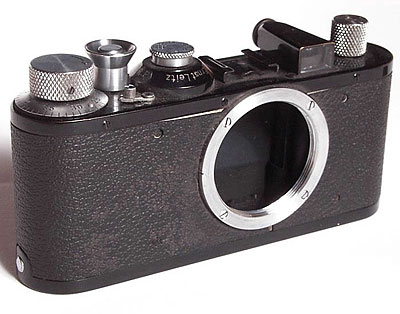
This is a Leica Standard. It's very much like the original Leica, which was built from 1925 to 1932. Leica added a rangefinder in 1931 and called that a Leica II but they built a rangefinderless version up to 1950. Most of those were called a Leica Standard.
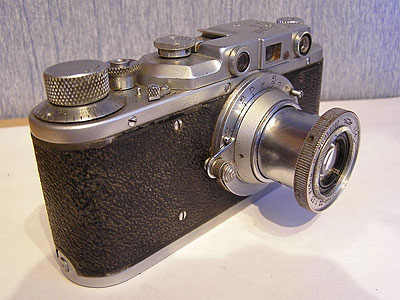
This is a Zorki 1. The FED 1 and Zorki 1 are like the Leica II, with a removable rangefinder cover unlike my Leica IIIc, which is an integral part of the body. Aki Asahi has coverings for the Zorki 1c and Id so I would use one of those. The #4040 Screwmount Leica Emboss surface leatherette would be very tasteful. The big problem would be covering the shutter speed mechanism on the top deck after removing the rangefinder mechanism.
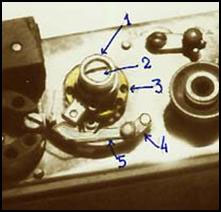
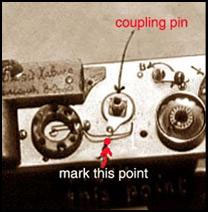
These two pictures are from Jay Javier's incredible FED-1 & ZORKIJ-1 Survival Site. They show the mechanism that needs to be covered. The round thing with the holes, on the left, supports the accessory shoe and can be removed. The Leica Standard used a dome shaped bell housing to cover this mechanism. That wouldn't be hard for a machinist to turn on a lathe. There would be holes in the top deck after removing the rangefinder mechanism but a little bondo would fill those in. Paint the upper deck and bottom plate black, mount the accessory shoe on the top deck and you have a Leica Standard clone. Put the appropriate viewfinder in the accessory show and start estimating distances, which would not be hard with a 28mm Orion 15 or a 35mm Jupiter 12. Or you could put on a Voigtlander 25/4 with the focusing click-stops. Even a 50mm Industar-50 is not that hard to estimate focus with when you are stopped down.
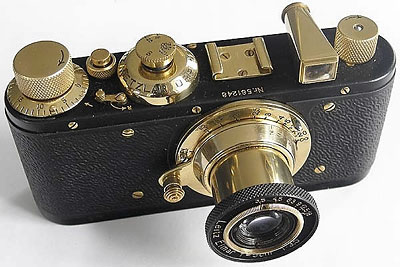
Someone at Rangefinder Forum point out that someone had already done it. This is a Russian fake Leica Standard made from a Zorki 1d. I don't know why they gold plated everything. What I had in mind would be much like this, minus the gold plate and the 50mm viewfinder. I would paint the shutter mechanism bell housing black and leave the knobs chrome. With a black Jupiter 12 on it I would have a very nice street shooter. Anyone have a Zorki 1 with a bad rangefinder and good shutter they want to sell at a reasonable price?
Some people who are enjoying using a Leica Standard: Leica Purity: The Leica Standard (1934)
As the Leica I (C) is nearly identical to the "Standard Leica," both camera models are presented together.
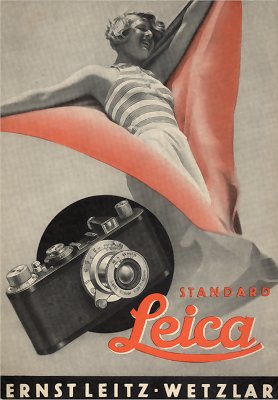
[more]
History of the Screw Mount Leicas
Update
My friend Blaine send me a suggestion for an alternative to the Zorki Standard. He suggested a Zarya.
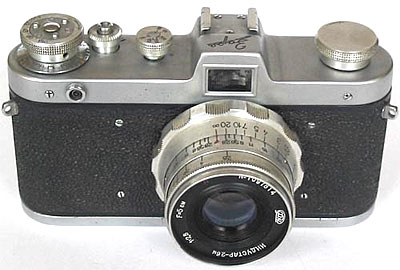
It's a FED 2 without a rangefinder and just a 50mm viewfinder. It's still too big. The Zorki 1 body is quite a bit smaller and the viewfinder on the Zarya adds extra bulk and, with a wideangle viewfinder, quite a bit extra height.

Another option I thought of was the modern Voigtlander Bessa L. Stephen Gandy doesn't seem to have any more of his $69 specials, but you can find them on eBay for under $100. It's a great camera with TTL metering and a modern shutter. Again, it's much larger than the Zorki and, this is the show stopper, it won't take the two of the lenses that I want to use on it: the 35mm Jupiter 12 and 50mm Industar-50. Onward. I will not be swayed in my search!
|
|
|
|

















